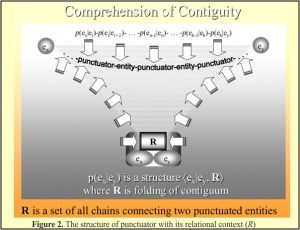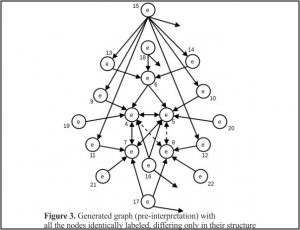Venkata Rajesh Kumar Tavva received his doctorate in Exact Humanities. He did his research work under the supervision of Late Prof. Navjyoti Singh and co-supervision of Prof. Kamalakar Karlapalem. The summary of Rajesh’s thesis, Vaiśeṣika Graph Grammar System: A Generative Ontology Approach, as explained by him is below:
Ontology, as a philosophical discipline of the study of reality, has gained traction in recent times and is appropriated into computer science giving rise to a new discipline called ‘Ontology Engineering’. One of the main goals of ontology engineering, is how to specify meaning to a computer. But that question takes us back to the foundational issue of what meaning is, and how does one go about studying it so that one can specify it to a computer as explicitly and as accurately as possible. The answer to this question lies in ‘Formal Ontology’.
Formal ontology is the study of forms of entities in reality as opposed to their contents. The term was first coined by Edmund Husserl who envisioned it as the ‘eidetic science of the object as such’ i.e., the study of all those features of an object insofar as they make it what it is i.e., an object. But what the forms of entities in reality are, and how to study them is still an open issue.
The notion of a formal ontology so far has been mainly understood as the application of formal logic, particularly First-Order Logic (FOL) and its variants, to ontology. But since FOL is based on propositional form which is primarily a syntactic form, and does not have any semantics of its own, it requires something outside itself to give semantics to it. One needs to look at various conceptions of reality to provide such semantics.
We look at three such conceptions of reality: (1) as sets of entities (2) as parts and wholes, and (3) as states of affairs (SOAs), and claim that the SOA-conception of reality is the most apt candidate to study reality formally and, in turn, to do formal ontology. But we also show that the propositional form, and in turn, FOL, is incapable of capturing the structure of SOAs. Though there had been various attempts to overcome the problems of classical logic, like FOL, by construction of new and alternative logics, almost all these logics still swear by the fundamental notion of the subject-predicate form (propositional form) which is fundamentally a sentential or linguistic or logical form as opposed to an entitative or extra-linguistic or ontological form. Hence these logics are also incapable of capturing the structure of SOAs. In fact, there has been so far no proper ontological form which captures the structure of SOAs, in toto.
We propose a non-propositional, non-set-theoretic, onto-logical form, called punctuator (Figure 2) to capture the structure of SOAs in toto, and in turn to do formal ontology.
We then consider Vaiśeṣika (Figure 1), the foundational ontology in Indian analytic tradition, and present a formalized version of it – Neo-Vaiśeṣika Formal Ontology (NVFO) – using only punctuators to give an instance of a formal ontology as construed above. NVFO was founded
by Singh (2002, 2003, 2008) and later refined and extended by Navjyoti Singh and Rajesh Tavva (Tavva & Singh, 2015).

Notwithstanding our appeal to take recourse to formal ontology to specify meaning to a computer explicitly, we also propose a novel idea called generative ontology to make the specification of this meaning to a computer as accurate as possible. In a generative ontology, potentially infinite number of complex ontological structures (SOAs/punctuators) can be generated from a finite number of atomic (or irreducible) ontological structures (SOAs/punctuators). This becomes possible because the form of punctuator is recursive in nature. A punctuator is a boundary (a non-entity) which brings two entities together in some relational context R which, itself, is further composed of chains of entities (and punctuators between them), hence making the structure of a punctuator complex as well as recursive. Because of this complexity of a punctuator as a web of entities and punctuators between them, the structure of a punctuator can be best understood as a graph (as composed of nodes and edges).

Graph grammars, being a natural extension of string as well as tree grammars, are highly expressive and powerful enough to capture the generative structure of a wide variety of scenarios – both simple and complex. Unfortunately, this power is not leveraged by many. Most of the graph grammars available hitherto are either toy grammars or limited to addressing highly specialized problems. The current thesis presents a domain-independent grammar i.e., a grammar for reality, as theorized in Vaiśeṣika. We contend that Vaiśeṣika ontology, given that it implicitly exhibits the ontological structure of a punctuator, is one such ontology which can be generated from some basic alphabet of punctuators. Hence it is not only a formal ontology but also a generative ontology. Given the fact that most of the existing
foundational ontologies (those which deal not with a particular domain of reality but with entire reality as such) are not generated but manually constructed, the idea of a generative ontology becomes significant because of its capacity to impart maximal objectivity and accuracy to such a system – which any formal ontology aims for – by making the scope of human intervention as minimal as possible, and at the same time generating a maximal portion of the system from a minimal alphabet.
We not only propose the idea of generative ontology, but also construct an entire system – Vaiśeṣika Graph Grammar System (VGGS) – which is based on NVFO, to demonstrate the idea. VGGS consists of generative rules (GRs), interpretive rules (IRs), proof of the soundness of the system, and parser rules (PRs) (to show that the system is decidable).
The generative rules enable us to generate complex Vaiśeṣika sentences (graphs) from simple alphabet (graphs) in such a way that, at the end of generation, all the nodes (except for those in the alphabet graphs) in the generated graphs have identical labels and hence cannot be differentiated from each other except through their structure/form (Figure 3). The interpretive rules identify the different formal structures of each of these nodes of generated graphs and enable us to label each of them with one of the Vaiśeṣika categories, purely on the basis of its ontological structure (Figure 4). So the difference between generative and interpretive rules of Vaiśeṣika can be thought of as the difference between syntax and semantics of reality. The graphs generated by the former – generative rules – refer to the syntactic portion of reality – they are forms or arrangements of entities in reality. Given the way entities are arranged we discern their meaning and categorize or classify them accordingly, and that is given by the latter – interpretive rules. This is also a defining characteristic of formal ontology – that we differentiate entities in reality purely based on the differences in their ontological forms. Though a form depends on its entity (entities) for its existence, an entity depends on its form for its meaning!


If every generated graph has at least one interpretation i.e., if every node of a generated graph can be labeled in terms of Vaiśeṣika categories, with no leftovers, then the graph is said to be a valid graph. And if every generated graph is found to be valid, then the system as a whole is said to be sound. We also provide a formal proof of the soundness of VGGS. We then present a parser to the system which can classify an input graph as valid/invalid Vaiśeṣika graph to show that the system is decidable as well.
We substantiate all the above claims not only theoretically but also practically by building in-house graph grammar software (Figure 5) where one can specify all the GRs, IRs and PRs presented in the thesis. Around 100k terminal graphs generated by the GRs are interpreted as well as parsed successfully to show that the system is sound and decidable, and in turn, empirically validate the theoretical insights presented in the thesis.

The main focus of the thesis is to make a case for a formal, foundational and generative ontology to not only specify meaning to a computer, but also to specify it as accurately as possible.
The main contributions of the thesis are:
- To make a case for a non-propositional, non-set-theoretic, onto-logical form called punctuator
- Explicit formalization of classical Vaiśeṣika by re-defining many Vaiśeṣika categories and subcategories purely in terms of inherence, contact and disjunct punctuators
- To build a computable graph grammar – which includes both generative as well as interpretive rules – for a foundational ontology making it a ‘Generative Ontology’ – a novel idea, not found elsewhere, to our knowledge
- To prove the soundness of the system (that every generated graph is interpretable) theoretically
- To show that the system is decidable by building a parser which enables one to decide if a given graph is derivable by the GRs or not
- To build an in-house graph grammar software, and generating, interpreting and parsing tens of thousands of graphs to substantiate the above claims not only theoretically, but also practically.
References
- Singh, Navjyoti. 2002. Formal Theory of Categories through the Logic of Punctuator (unpublished)
- Singh, Navjyoti. 2003. “Theory of Experiential Contiguum”, in Philosophy and Science: Exploratory Approach to Consciousness. Kolkata: Ramakrishna Mission Institute of Culture
- Singh, Navjyoti. 2008. Idea of Punctuator and Ontology (unpublished)
- Tavva, R., and Singh, N. 2015. Generative Ontology of Vaiśeṣika. Paper presented at JOWO, 24th International Joint Conference on Artificial Intelligence (IJCAI), Buenos Aires, Argentina

